I have seen some seramas being posted that don't have good type. I just want to let everyone know what a serama i supposed to look like so they don't get ripped off. Here is an article from scnaonline.org , "Ideal Hen Updated" . I am going to show a picture of one nearly perfect hen. If you buy one of these, that is WONDERFUL. It is harder to get good type on females than males because the pose is more natural for them. I am also going to show pictures of some BYC breeders birds that I have seen on the online poultry show. These breeders are working hard to strive toward the standard. Their hens are more "average"good quality. Meaning that they have great birds but they aren't like one of the national champion birds. I would recommend buying a hen if it looks like theirs. The article:
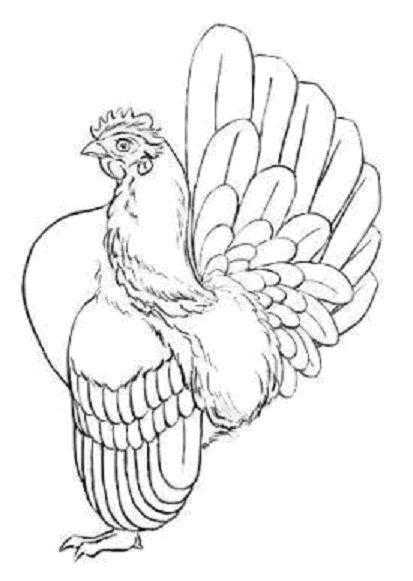
This drawing represents the type to be working to-
ward. The
breast is very large and somewhat exaggerated in this
drawing
to stress the importance of it. The head and tail are
shown touching. This is in pose and shows an extreme
amount of reach, with full large breast and head and
tail
touching. Note that the wing is not touching the
ground. This
is very important. The wing should clear the ground
and allow
a small amount of the foot to show. This will keep the
wings clean and from being tattered by being longer
than the
foot. A medium length leg is essential to achieving this
wing
carriage, as the short legs allow the wing to drag. In
selecting
within your breedings, remember to select toward these
points
of form. The males will be easier to breed into this
form, as it
is more natural to them. The females are further from
this
idea at this time and will take longer to select to this
level. By
selecting height, breast and reach-in-pose on the
hens, while
still keeping soundness and reproducibility in mind.
Shape of the Female
Comb: Single, small, set firmly and evenly on the head, straight and upright, evenly serrated with five regular and distinct points, the middle points the same length as the width of the blade, moderately arched, blade should extend well over the back of the head.
Beak: Strong, stout, and well curved.
Face: Small, rounded, smooth, fine in texture, free from wrinkle or folds.
Eyes: Round, conspicuous.
Wattles: Small, round, fine in texture, free from wrinkles or folds.
Ear Lobes: Small, oval, fitting closely to head.
Head: Small, carried well back in proud manner.
Neck: Medium length, backward arched showing off breast, full, tapering gracefully from shoulders to head.
Hackle: Abundant, flowing naturally from front of neck reaching far back covering both shoulders.
Back: Short, broad, in profile, shaped like a V with neck and tail forming the vertical sides.
Cushion: Short, feathers broad and plentiful.
Tail: Moderately large and upright, carried in an upright position so as to almost contact the back of head.
Main Tail: Feathers wide, moderately spread in a neatly overlapping manner, rising above the head, A shaped from the rear view.
Coverts: Abundant, becoming very broad, flowing well up tail.
Wings: Large, long, closely folded, carried vertically not quite touching the ground, Shoulders and Fronts: Prominent, slightly concealed by hackle.
Bows: Well rounded.
Coverts: Feathers broad, forming two distinct bars across wings.
Primaries: Moderate width, rather long, completely concealed by secondaries.
Secondaries: Broad, tapering convexly to rear, wing bay well exposed.
Breast: Highly lifted, well developed, full, carried prominently forward beyond vertical line drawn from point of beak, broad and well rounded, from head to neck to breast S shaped profile.
Body & Stern: Body- short, good depth and width, sloping from front to rear. Stern: Fluff, short, abundant.
Legs & Toes: Legs- average length -- widely set, parallel to each other without bowing or knock ed knees, well proportioned.
Lower Thighs: Medium, stout at top and tapering to hocks.
Shanks: Medium, smooth, round, evenly scaled.
Toes: Four, straight, well and evenly spread, evenly scaled.
Appearance: Small, broad, compact, active, tame, standing up majestically.
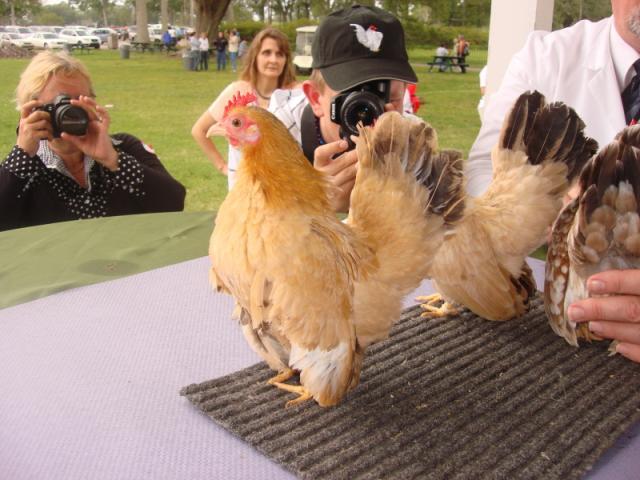
Here is a nearly perfect hen that did well in the "Cajun Classic" in Vacherie, Louisiana in April 18 and 19 2009. The caption under the picture, which I found on the SCNA forum is "Highest Scoring Bird at The Show
96 - Cipora, "B" Black Tail Buff Hen - Jerry Schexnayder"
"Ideal Male Updated" . I am going to show a picture of one nearly perfect rooster. If you buy one of these, that is WONDERFUL. I am also going to show pictures of some BYC breeders birds that I have seen on the online poultry show. These breeders are working hard to strive toward the standard. Their roosters are more "average"good quality. Meaning that they have great birds but they aren't perfect,like one of the national champion birds. I would recommend buying a hen if it looks like theirs. The article:
This drawing shows the ideal form of the American
Serama male. This drawing represents the type to be
working toward. The breast is very large and some-
what exaggerated in this drawing to stress the impor-
tance of it. The head and tail are shown touching.
This is in pose and shows an extreme amount of
reach, with full large breast and head and tail touch-
ing. Note that the wing is not touching the ground.
This is very important. The wing should clear the
ground and allow a small amount of the foot to show.
This will keep the wings clean and from being tattered
by being longer than the foot. A medium length leg is
essential to achieving this wing carriage, as the short
legs allow the wing to drag. In selecting within your
breedings, remember to select toward these points of
form. The males will be easier to breed into this form,
as it is more natural to them. The females are further
from this idea at this time and will take longer to select
to this level. By selecting height, breast and reach-in-
pose on the hens, while still keeping soundness and
reproducibility in mind, we can produce this form with-
out hurting the breed.
Comb: Single, medium, set firmly and evenly on head, straight and upright, evenly serrated with five regular and distinct points, the middle points the same length as the width of the blade, moderately arched, blade should extend well over back of head.
Beak: Strong, stout and well curved.
Face: Small, rounded, smooth, fine in texture, free from wrinkle or folds.
Eyes: Round, conspicuous.
Wattles: Medium, round, fine in texture, free from wrinkles or folds.
Ear Lobes: Small, oval, fitting closely to the head.
Head: Small, carried well back in a proud manner.
Neck: Medium length, backward arched, showing off breast, full, tapering gracefully from shoulders to head.
Hackle: Abundant, flowing naturally from front of neck reaching far back covering both shoulders.
Back: Short, broad, in profile, shaped like a 'V' with neck and tail forming the vertical sides.
Tail Coverts & Saddle: Slightly curved, sword shaped hanging over the abdomen and covering back, widely spread, overlapping the tail and lesser sickles.
Tail: Moderately large and upright, carried in an upright position so as to almost contact the back of head.
Main Tail: Feathers wide, moderately spread in a neatly overlapping manner, rising above the head, A shaped from the rear view.
Main Sickles: Medium to long, strong, firm, broad sword-shaped slightly curved.
Lesser Sickles: Well-spread, medium length slightly upright, sword-shaped sickle feathers covered with coverts.
Coverts: Abundant, becoming very broad, flowing well up tail.
Wings: Large, long, closely folded, carried vertically not quite touching the ground, Shoulders and Fronts: Prominent, slightly concealed by hackle.
Bows: Well rounded.
Coverts: Feathers broad, forming two distinct bars across wings.
Primaries: Moderate width, rather long, completely concealed by secondaries.
Secondaries: Broad, tapering convexly to rear, wing bay well exposed.
Breast: Highly lifted, well developed, full, carried prominently forward beyond the vertical line drawn from point of beak, broad and well rounded, from head to neck to breast S shaped profile.
Body & Stern: Body- short, good depth and width, sloping from front to rear. Stern: Fluff, short, abundant.
Legs & Toes: Legs- average length, widely set, parallel to each other without bowing or knocked knees, well proportioned.
Lower Thighs: Medium, stout at top and tapering to hocks.
Shanks: Medium, smooth, round, evenly scaled.
Toes: Four, straight, well and evenly spread, evenly scaled.
Appearance: Small, broad, compact, active, tame, standing up majestically.
Nearly perfect male:
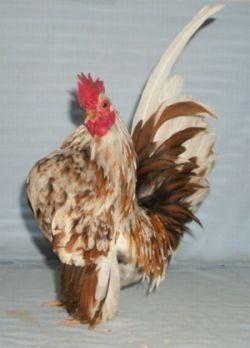
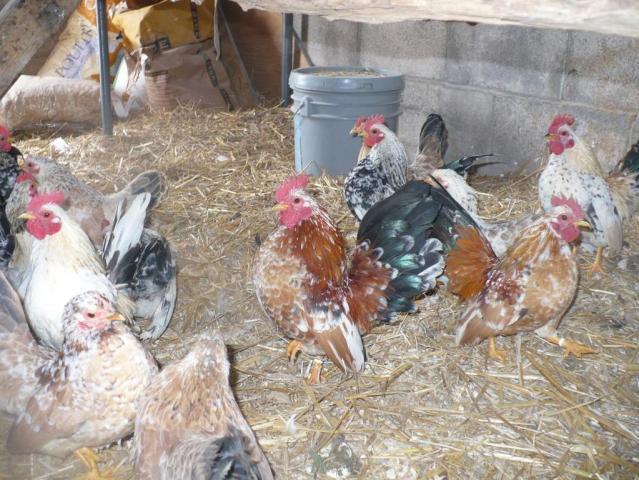
A group by BluegrassBantams
A frizzled cock by BluegrassBantams
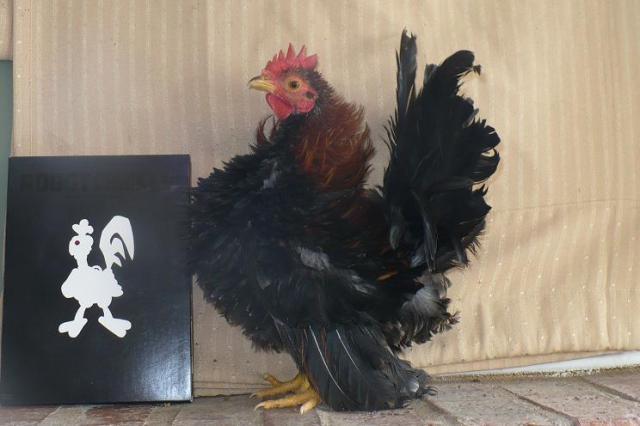
chickn's rooster:
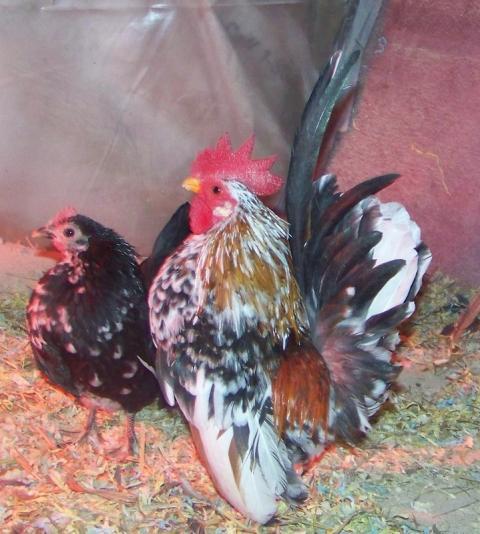
If I used your picture and you didn't want me to, PM me.

This drawing represents the type to be working to-
ward. The
breast is very large and somewhat exaggerated in this
drawing
to stress the importance of it. The head and tail are
shown touching. This is in pose and shows an extreme
amount of reach, with full large breast and head and
tail
touching. Note that the wing is not touching the
ground. This
is very important. The wing should clear the ground
and allow
a small amount of the foot to show. This will keep the
wings clean and from being tattered by being longer
than the
foot. A medium length leg is essential to achieving this
wing
carriage, as the short legs allow the wing to drag. In
selecting
within your breedings, remember to select toward these
points
of form. The males will be easier to breed into this
form, as it
is more natural to them. The females are further from
this
idea at this time and will take longer to select to this
level. By
selecting height, breast and reach-in-pose on the
hens, while
still keeping soundness and reproducibility in mind.
Shape of the Female
Comb: Single, small, set firmly and evenly on the head, straight and upright, evenly serrated with five regular and distinct points, the middle points the same length as the width of the blade, moderately arched, blade should extend well over the back of the head.
Beak: Strong, stout, and well curved.
Face: Small, rounded, smooth, fine in texture, free from wrinkle or folds.
Eyes: Round, conspicuous.
Wattles: Small, round, fine in texture, free from wrinkles or folds.
Ear Lobes: Small, oval, fitting closely to head.
Head: Small, carried well back in proud manner.
Neck: Medium length, backward arched showing off breast, full, tapering gracefully from shoulders to head.
Hackle: Abundant, flowing naturally from front of neck reaching far back covering both shoulders.
Back: Short, broad, in profile, shaped like a V with neck and tail forming the vertical sides.
Cushion: Short, feathers broad and plentiful.
Tail: Moderately large and upright, carried in an upright position so as to almost contact the back of head.
Main Tail: Feathers wide, moderately spread in a neatly overlapping manner, rising above the head, A shaped from the rear view.
Coverts: Abundant, becoming very broad, flowing well up tail.
Wings: Large, long, closely folded, carried vertically not quite touching the ground, Shoulders and Fronts: Prominent, slightly concealed by hackle.
Bows: Well rounded.
Coverts: Feathers broad, forming two distinct bars across wings.
Primaries: Moderate width, rather long, completely concealed by secondaries.
Secondaries: Broad, tapering convexly to rear, wing bay well exposed.
Breast: Highly lifted, well developed, full, carried prominently forward beyond vertical line drawn from point of beak, broad and well rounded, from head to neck to breast S shaped profile.
Body & Stern: Body- short, good depth and width, sloping from front to rear. Stern: Fluff, short, abundant.
Legs & Toes: Legs- average length -- widely set, parallel to each other without bowing or knock ed knees, well proportioned.
Lower Thighs: Medium, stout at top and tapering to hocks.
Shanks: Medium, smooth, round, evenly scaled.
Toes: Four, straight, well and evenly spread, evenly scaled.
Appearance: Small, broad, compact, active, tame, standing up majestically.

Here is a nearly perfect hen that did well in the "Cajun Classic" in Vacherie, Louisiana in April 18 and 19 2009. The caption under the picture, which I found on the SCNA forum is "Highest Scoring Bird at The Show
96 - Cipora, "B" Black Tail Buff Hen - Jerry Schexnayder"
"Ideal Male Updated" . I am going to show a picture of one nearly perfect rooster. If you buy one of these, that is WONDERFUL. I am also going to show pictures of some BYC breeders birds that I have seen on the online poultry show. These breeders are working hard to strive toward the standard. Their roosters are more "average"good quality. Meaning that they have great birds but they aren't perfect,like one of the national champion birds. I would recommend buying a hen if it looks like theirs. The article:
This drawing shows the ideal form of the American
Serama male. This drawing represents the type to be
working toward. The breast is very large and some-
what exaggerated in this drawing to stress the impor-
tance of it. The head and tail are shown touching.
This is in pose and shows an extreme amount of
reach, with full large breast and head and tail touch-
ing. Note that the wing is not touching the ground.
This is very important. The wing should clear the
ground and allow a small amount of the foot to show.
This will keep the wings clean and from being tattered
by being longer than the foot. A medium length leg is
essential to achieving this wing carriage, as the short
legs allow the wing to drag. In selecting within your
breedings, remember to select toward these points of
form. The males will be easier to breed into this form,
as it is more natural to them. The females are further
from this idea at this time and will take longer to select
to this level. By selecting height, breast and reach-in-
pose on the hens, while still keeping soundness and
reproducibility in mind, we can produce this form with-
out hurting the breed.
Comb: Single, medium, set firmly and evenly on head, straight and upright, evenly serrated with five regular and distinct points, the middle points the same length as the width of the blade, moderately arched, blade should extend well over back of head.
Beak: Strong, stout and well curved.
Face: Small, rounded, smooth, fine in texture, free from wrinkle or folds.
Eyes: Round, conspicuous.
Wattles: Medium, round, fine in texture, free from wrinkles or folds.
Ear Lobes: Small, oval, fitting closely to the head.
Head: Small, carried well back in a proud manner.
Neck: Medium length, backward arched, showing off breast, full, tapering gracefully from shoulders to head.
Hackle: Abundant, flowing naturally from front of neck reaching far back covering both shoulders.
Back: Short, broad, in profile, shaped like a 'V' with neck and tail forming the vertical sides.
Tail Coverts & Saddle: Slightly curved, sword shaped hanging over the abdomen and covering back, widely spread, overlapping the tail and lesser sickles.
Tail: Moderately large and upright, carried in an upright position so as to almost contact the back of head.
Main Tail: Feathers wide, moderately spread in a neatly overlapping manner, rising above the head, A shaped from the rear view.
Main Sickles: Medium to long, strong, firm, broad sword-shaped slightly curved.
Lesser Sickles: Well-spread, medium length slightly upright, sword-shaped sickle feathers covered with coverts.
Coverts: Abundant, becoming very broad, flowing well up tail.
Wings: Large, long, closely folded, carried vertically not quite touching the ground, Shoulders and Fronts: Prominent, slightly concealed by hackle.
Bows: Well rounded.
Coverts: Feathers broad, forming two distinct bars across wings.
Primaries: Moderate width, rather long, completely concealed by secondaries.
Secondaries: Broad, tapering convexly to rear, wing bay well exposed.
Breast: Highly lifted, well developed, full, carried prominently forward beyond the vertical line drawn from point of beak, broad and well rounded, from head to neck to breast S shaped profile.
Body & Stern: Body- short, good depth and width, sloping from front to rear. Stern: Fluff, short, abundant.
Legs & Toes: Legs- average length, widely set, parallel to each other without bowing or knocked knees, well proportioned.
Lower Thighs: Medium, stout at top and tapering to hocks.
Shanks: Medium, smooth, round, evenly scaled.
Toes: Four, straight, well and evenly spread, evenly scaled.
Appearance: Small, broad, compact, active, tame, standing up majestically.
Nearly perfect male:


A group by BluegrassBantams
A frizzled cock by BluegrassBantams

chickn's rooster:

If I used your picture and you didn't want me to, PM me.








